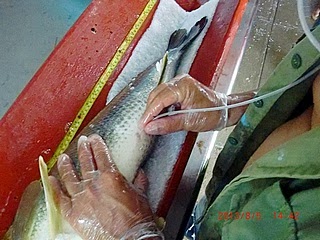Seed production of common snook (Centropomus undecimalis) in Cuba
Masatoshi Futagawa
December 3, 2013
Since 2008 JICA-CIP project is running, development of seed
production technique about mutton snapper (Lutjanus
analis) and common snook (Centropomus
undecimalis), at Santa Cruz del Sur in Cuba. The project produced some
snapper and snook juveniles in 2013 with semi intensive seed production method with
copepods (SISPC). It is the first history of successful marine seed production
about both species in Cuba, and second of the world about common snook especially.
Common snook has high demand in the
market and sports fishing in Central America. However, seed production of the
species is very difficult due to its small mouth which unable to intake rotifer
at larva stage. The project introduced maturation inducement by HCG (Human chorionic
gonadotropin) for broodstock and SISPC, rearing large pond and fed wild copepoda
nauplius, for larva culture. The project collected around one million eggs and
produced 3 thousand juveniles (TL 6 cm, BW 2 g) at 71 dph (days post hatch-out).
The fish are reared intensively and have showed high growth. The project
preparing semi intensive culture at vacant shrimp pond for reduce production
cost and easy culture.
Maturation inducement and spawning
According to Carlos Yanes Roca and Kevan L. Main, rising of water temperature triggered
to spawning of common snook from May to September, June and July especially,
and the fish spawn within 3 days after new or full moon in Florida. Our wild
captured broodstock (2 years rearing, 7 females and 20 males, ABW 2.5 Kg) showed
well appetite which related to water temperature increasing, from July 2013.
The project added fish oil, supplement for human, and shrimp to moist pellet
for increase egg quality.
On August 5 (new moon), 5 females showed
over 400 µm egg diameters and 7 males had sperm according to cannulation even
sperm and eggs were not observed to pressed abdomen. We injected HCG (500IU/Kg)
at dorsal part of all fishes (male and female). Spawning (977 thousand eggs)
occurred on following day and a little more egg on 8th and 9th.
The eggs showed a diameter of 665±14μm with 1 to 3 oil droplet, well floating
egg rate (91.8 %) and hatch-out rate (78.3 %) and survival rate until 2 dph was
over 80 %.
Seed production under SISPC
Semi intensive seed production method with
copepods (SISPC) is producing seeds at large tank or pond and feed propagation
wild copepods under low density culture. The advantages are: do not require cultured
rotifer which needs several equipment and intensive management, and easy to
produce seeds. Disadvantages are low survival (1 -5 %) and difficult to
estimate survival.
The project stocked larvae (300
thousand, 2 dph, SL 2 mm) at reservoir (1600 ton) on August 9. We gave aeration
with 3 air stones from 5 dph, applied ammonia sulfate (1 ppm) and super phosphate
(2.2 ppm) on 16 dph, and supplied water (800 ton whole culture period) when low
water level. From 15 dph, several larvae were observed at surface and feeding
started. During culture period, we fed rotifer (106 million, unenriched),
Artemia nauplii (64 million), fish eggs (11 million), ground fish meat (5.3
Kg), moist pellet (3.0 Kg) and dry crumble (8.7 Kg). Also, coconuts leaves were
installed for shelter and confirmed that fries lived on 37 dph. Wild small
crabs were observed inside stomach on 53 dph and dry pellet was taken 4 % (dry
weight) of body weight based on stomach contents on 68 dph.
Based on observation and sampling, fries
were shown at surface from 16 dph, body shows transparent, orange mark at opercle
by blood, and air bladder appear clearly. On 19 dph, lower jaw extended as sign
of carnivorous, TL reached 10 mm. Black spot appeared at tip of 1st
dorsal fin on 23 dph that remained until juvenile stage. On 27 dph TL reached
12 mm, the head grows big due to development of jaws. Fry grew TL 17 mm and BW
0.04 g and black spot occupied half of the fin. On 46 dph, grew TL 26 mm and BW
0.2 g, spine of anal fin extended to improve exercise capacity to capture other
fish possibly. Fry grew to TL 42 mm and BW 0.8 g on 55 dph, show high growth
(refer growth curve at figure below), and anal fin spine extend longer. On 66
dph, fry grew TL 53 mm and BW 1.6 g and body color turn to silver due to
development of scales, and the black spot shrunk. On October 17, juvenile (3017
fishes, 71 dph, TL 59 mm, SL 47 mm, BW 2.1 g) were collected (SR 1.0 %) by
purse-net and stocked two 10 ton tanks according to size.
It is proved that SISPC produce common
snook seed that fed ground fish meat and supply some water without sophisticate
rotifer culture and intensive care. Especially common snook seed production is
very difficult with intensive seed production fed with rotifer due to its small
mouth during larva stage. Even so, SISPC has task about improvement of survival
(reduce cannibalism) that occurred 40 to 60 dph. For the next trial, we are
planning to install more shelters, early harvest or partial harvest to improve
survival. Also, culture with small tank (40 to 90 ton) and select size by net
and harvest easily.
In addition to that, the juveniles showed
well appetite of moist pellet and fast growth, large group (719 n) reached 15 g
and small group (2019 n) grew 4 g on 91 dph with FCR 1.5. We are planning to
rear experiment at vacant shrimp pond that reduces production cost and culture
easily.


























Comments
Post a Comment